In the Hills of West Virginia
The Appalachian hills provide the setting for an ornate palace dedicated tot he great spiritual master who brought love of Krishna to the West.
by Yogesvara dasa
Just around a bend in the road, crowning a lush green hill surrounded by valleys and forests in the West Virginia panhandle, stands Prabhupada’s Palace of Gold, a handcrafted seven-years-in-the-making miracle of inlaid marble walls and floors, stained-glass windows, crystal chandeliers, and a three-hundred-ton gold-leafed dome that glitters like a second sun. In the words of one commentator for The Today Show, “You won’t believe your eyes.”
How did it get there? Who built it? And why? Such questions never fail to cross the minds of the half million visitors who come from all over the world each year to see ‘The Taj Mahal of the West.” The Palace was built by the devotees of New Vrindaban. the West Virginia farm community of the International Society for Krishna Consciousness (ISKCON). as a memorial to ISKCON’s founder and spiritual guide. His Divine Grace A.C. Bhaktivedanta Swami Prabhupada.
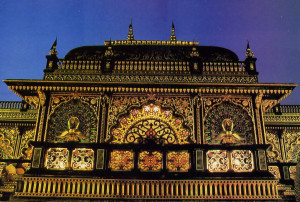
Apart from its architectural and artistic appeal, the Palace is also a place of worship where devotees of Lord Krsna honor their spiritual master, a lifelong devotee of God, for his work of establishing Krsna consciousness—love of God—around the world.
How much is the Palace worth? Some experts have guessed 10 to 15 million dollars, but they’re quick to add that such work just isn’t done any more, so an accurate estimate is difficult. So far, the devotees have actually invested only $600,000 for construction materials and equipment. And they did the work themselves.
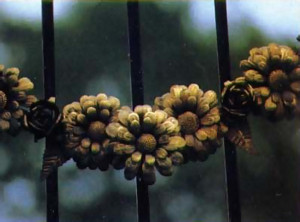
Where did the money come from? During the seven years of construction more than 200 community members and supporters raised it through private donations and from the Palace’s thriving tourism. Also helpful were contributions from the Hindu community (who see Krsna temples as their “home away from home”) and income from commissioned work by devotee artists, such as the mural in Wheeling’s Civic Center, painted by New Vrindaban resident Muralidhara dasa.
The New Vrindaban community was started in 1968 by Srila Kirtanananda Swami Bhaktipada, one of Srila Prabhupada’s first disciples. Srila Bhaktipada came to West Virginia to set up a farm that would demonstrate the principles of Krsna conscious life: simple living, based on nature and the cows, balanced by ”high thinking”—in short, a life dedicated to the service of God, free from the dependencies of consumer civilization. Such a palace, he hoped, would also be a pilgrimage site, a Western version of Vrndavana, the village in India where Lord Krsna appeared five thousand years ago.

But how does an elaborate royal palace fit in with such nonmaterialistic aspirations? Devotees explain that simplicity in their own lives does not rule out opulence in the worship of God or His representatives. They also view the Palace as a mark of Krsna culture, where interested people can learn the basic principle spiritual life. And the Palace also serves a place of celebration. Annual festivals draw tens of thousands of pilgrims to attend ceremonies, plays, and feasts cooked in huge kitchens behind the Palace.
In its design the Palace is unique. While most churches and cathedrals reflect orthodox motifs of their culture, the ace is a blending of Eastern and Western styles, as if to say that service to God is the universal principle of all religions. While the Eastern roots of the Krsna consciousness movement can be seen in the intricate latticework, peacock windows, and traditional marble patterns, the movement’s presence in the West is reflected castlelike railings, cathedral-inspired arches, and bright color combinations.

The Palace actually started out in 1973 to be a simple home for Srila Prabhupada who had come to America eight years earlier, at age sixty-nine, to spread teachings of Lord Krsna. When Prabhupada passed away in 1977, Bhaktipada decided to make it into a memorial, and the residents of New Vrindaban set out to transform a home palace.
Without any prior training in construction, masonry, or the other skills for such a task, the devotees set to work. Acquiring advice and help along the way, they learned architecture, bricklaying, carpentry, plumbing, electrical work, casting, marble cutting and polishing, stained-glass making, and landscaping. Mothers with their children, men young and old friends and neighbors—each person worked in the spirit of Bhagavad-gita, the main text of Krsna devotees:
All that you do, all that you eat, all that you offer and give away, as well as any sacrifice that you may perform, should be done as an offering to Me.
The winters were often bitter cold. Earth turned to mud ankle-deep, and some of the less hardy left the farm in defeat. The work went on, however, fired by Srila Bhaktipada’s vision of a holy place in the hills of West Virginia, and the dream slowly became a reality.
A Tour of the Palace

What makes the Palace shine so brightly is its outer covering of 22-karat gold leaf—8,000 square feet of sheets one thousandth of an inch thick, protected by four layers of shellac. Entering the Palace through one of two main doors, we find ourselves beneath an arched ceiling painted as a Himalayan landscape. Devotee artists airbrushed the large areas and then added details by hand. They assembled 11,000 pieces of Austrian crystal to make the forty-two chandeliers that illuminate the main hallway. Each chandelier is color-coordinated to match the stained-glass windows.
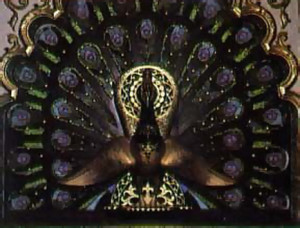
For the walls and floors of the Palace, devotees imported forty different kinds of marble and onyx from Italy, France, Turkey, and Brazil. They cut the large raw slabs into more than 20,000 smaller pieces, polished them all, and shaped them into delicate inlaid designs. Then each ensemble was polished and fitted into place. In all, the 35,000 square feet of the Palace display 254 tons of marble.

The first room we see down the left hallway is the reception room, with furnishings handcrafted at New Vrindaban’s marble shop. Here we see photo displays of Srila Prabhupada’s worldwide missionary activities. The door is fitted with sand-blasted glass, designed and shaped pieces of glass. Stones from Czechoslovakia further decorate each window. In India, peacocks are regarded as creatures of good fortune, and Lord Krsna is easily recognized by the peacock feather in His hair.
Continuing down the left hallway, we see the kitchen, where devotees cook vegetarian foods according to ancient recipes. The food is prepared six times daily and offered to Srila Prabhupada in the main temple as an act of devotion.
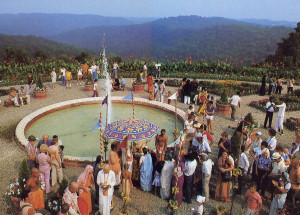
Once we reach the back hallway, we look out onto twenty acres of sculpted gardens and a terrace that serves as a stage for devotional plays and concerts. The terrace is the roof of an underground mall that houses a restaurant, a museum, a library, and a display area where devotees demonstrate their crafts. Beyond the gardens is a guest pavilion, with a large meeting hall and sixty rooms.
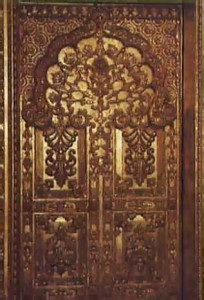
As we continue around the hallway, we come to the study, where devotees have installed a lifelike form of Srila Prabhupada posed at his work of translating the Sanskrit scriptures of Krsna consciousness into English. In his lifetime Srila Prabhupada published seventy volumes of devotional literature, which universities across the country have acquired as standard reference works. (Srila Prabhupada’s disciples have translated his writings into sixteen languages.) It took devotees more than two years to complete the walls of the study. The teakwood furniture was carved by a devotee family in Bombay. The vases, of ancient Chinese origin, were donated by one of Srila Prabhupada’s disciples, Alfred Ford, the great-grandson of Henry Ford.

In the next room, Srila Prabhupada’s bedroom, we see walls made of Italian Botticino marble inlaid with onyx. The ceiling was painted by devotees lying on their backs, Michelangelo-style. The nine hundred flowers decorating the walls took a devotee artist four months to paint.
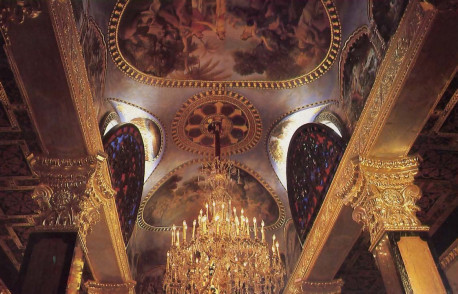
In the center of the Palace is the main temple. Here daily classes and ceremonies take place, lit by a 150-year-old French chandelier gold-plated by New Vrindaban craftspeople. Paintings on the ceiling depict scenes from the pastimes Lord Krsna performed when He was present on this planet five thousand years ago. The two central paintings show Sri Caitanya Mahaprabhu chanting God’s holy names in India five hundred years ago and Lord Krsna dancing with His most intimate devotees, the cowherd damsels of Vrndavana.
Adorning the walls of the temple are paintings of the saintly teachers who in recent generations have transmitted the ancient science of Krsna consciousness for the benefit of mankind. Srila Prabhupada, thirty-second in the disciplic line of teachers from Lord Krsna, presides over the temple from a gilded throne beneath a dome of cast gypsum and 4,200 pieces of cut glass.
Some Often-Asked Questions
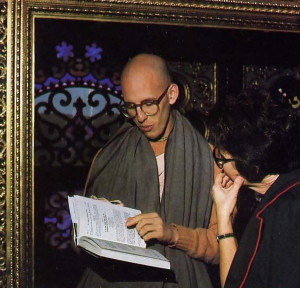 When people tour the Palace, they usually have lots of questions about the ideas and practices of the devotees and about their international Society.
When people tour the Palace, they usually have lots of questions about the ideas and practices of the devotees and about their international Society.
What is the meaning of the shaved head and robes?
Devotees of Lord Krsna have traditionally shaved their heads as a sign of renunciation, an indication that their concern is for the eternal beauty of the soul and not the temporary appearance of the body. The robes are the devotees’ traditional uniform, orange and saffron for celibate students, white for married students.
What is the mark the devotees wear on their foreheads?
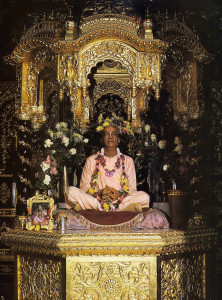
Devotees anoint their bodies with sacred clay from the original Vrndavana in India as a reminder that the body is a temple of God. The mark, called tilaka, is also a reminder that the mission of human life is service to the Supreme Lord.
What are the vows of a devotee?
To receive initiation into Krsna consciousness a person must abstain from meat, fish, and eggs; from intoxicants, including coffee, tea, and cigarettes; from illicit sex; and from gambling. Initiated devotees also chant the Hare Krsna mantra on prayer beads and attend temple ceremonies that begin at 4:15 A.M.
Do devotees accept Jesus Christ?
Devotees who worship Krsna as God accept Jesus Christ as the son of God and sincerely try to put his teachings to work in their daily lives.
How is Krsna consciousness different from Christianity?

There is no difference in essence, for the common platform of all religions is love of God. Devotees worship the same one God of all creation glorified in the Bible. The teachings of the Bible and those of Bhagavad-gita are essentially the same: worship the Lord of creation and do everything as an offering to Him. But there are differences also. For example, some Christians believe that animals have no souls. The Krsna conscious scriptures, however, say that since the life symptoms visible in humans are also visible in animals, the animals also have souls, and man’s predominance over animals is not a sanction to slaughter them but a mandate to protect them. This is the philosophical basis of the cow protection program at New Vrindaban.
Why do you put a statue of your spiritual master on the altar?
The Krsna conscious scriptures explain that God’s representative should be honored as highly as God Himself, because he is very dear to God. The spiritual master spreads God’s word and has no selfish motive in his life. By honoring the spiritual master and following his teachings, devotees imbibe his elevated qualities and advance in their own spiritual lives.
How do you educate your children?
The Krsna consciousness movement has opened several primary and secondary schools for academic and religious instruction. Devotee children learn all the basics-reading, writing, arithmetic, history, geography—but also receive training in the principles of religion: cleanliness, honesty, compassion. and self-control. There is hardly any television, but devotee children have much to replace it. Every week they take hikes, go swimming. learn to play musical instruments, and take part in the feasts and festivals of the community. And most of them are academically on par with children two or three grade older.
What are your plans for the future?
That’s a pretty big question. For the answer, please turn to page 27.

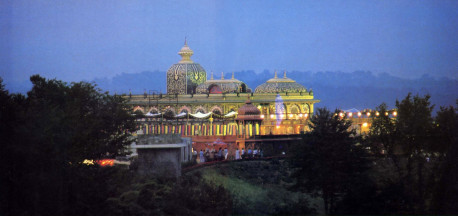
I am doing research on a lord sai baba how would I get information or talk to someone about this o have visited the palace before and this is for my own personal information 3049311686
Hare Krsna , Iam Reading It from Bangladesh. Iam very happy to see this!